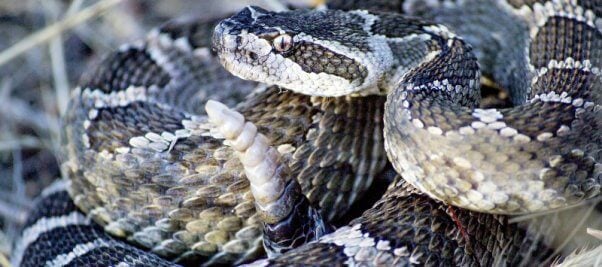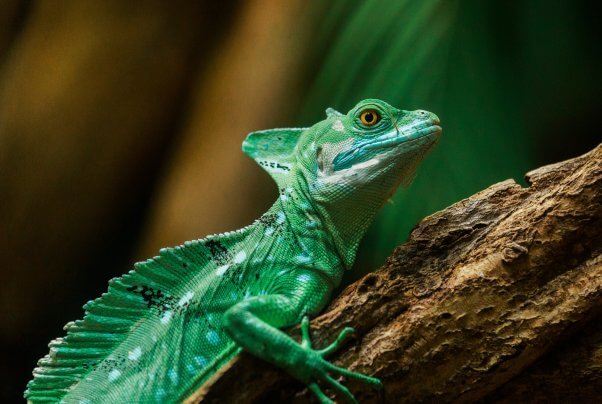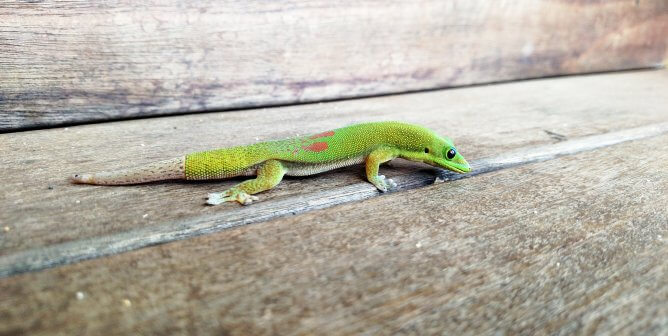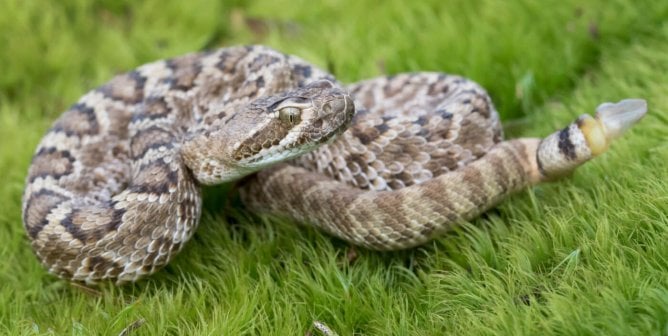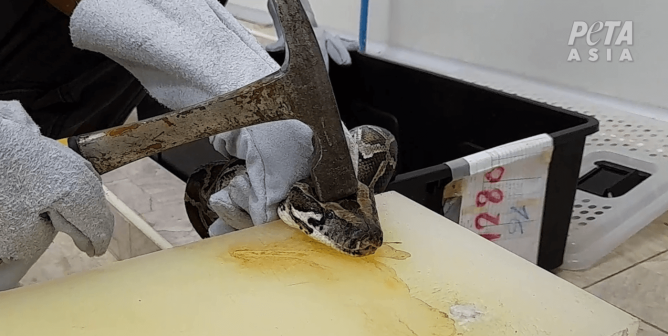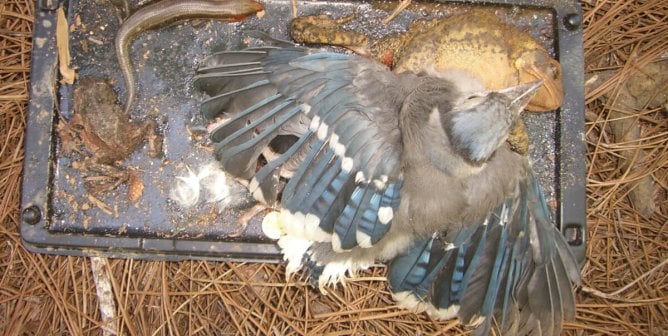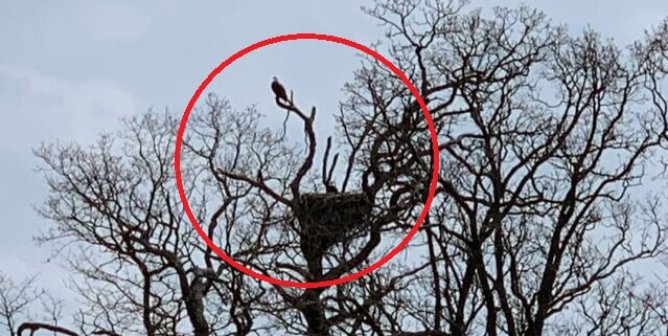Exotic Skins: The Animals
The snakes, alligators, crocodiles, and other reptiles who are killed for their skins suffer immensely. Snakes are commonly nailed to trees and their bodies are cut open from one end to the other. Their mutilated bodies are then discarded, but because of these animals’ slow metabolism, it can take hours for the snakes to die. Lizards are often decapitated, and some writhe in agony as the skin is ripped from their bodies. Most alligator skins come from farmed animals who are raised in crowded tanks or pools of fetid, stinking water. The animals are shot or crudely bludgeoned with hammers. Workers sometimes use a mallet and chisel to sever crocodiles’ spinal cords—which paralyzes, but does not kill, the animals. Herpetologist Clifford Warwick, a specialist in reptile biology and welfare, says, “There is no scientific question as to whether alligators are capable of feeling pain and sensitivity to stress—they are.” Dr. Warwick also found that farmed crocodiles often “develop abnormalities and deformities because they can’t walk or swim” in the crowded enclosures.
There are few laws to protect reptiles from abuse, and those that do exist are often not enforced. For example, although animals such as anacondas and crocodiles are covered by Convention on International Trade of Endangered Species (CITES) regulations, it is estimated that for every animal who is legally killed for the exotic skins trade, another will be illegally poached. In the United States, reptiles are excluded from the meager protections afforded by the Animal Welfare Act. In addition to being cruel, this industry is extremely wasteful: It can take the skins of four crocodiles to make a single bag.
Snakes
Snakes have been around since dinosaurs roamed the Earth, and today they number more than 3,000 species. Most of the snakes who live near humans are harmless, and snake encounters are rare, thanks to snakes’ keen ability to detect vibrations using their bellies and lower jaws. Their forked tongues also act like built-in radar to help them know what’s going on around them.
Read more
Most snakes live underground or under rocks; some live in trees and slide around eating insects and small animals. Many snakes lay eggs that are incubated by the sun, while others, such as garter snakes and rattlesnakes, carry their eggs in their bodies and give birth to fully developed young. Female pythons wrap their bodies around their eggs and shiver to heat themselves up to keep the eggs warm.
To kill snakes for their skins, hunters invade their homes and often nail them to trees and skin them alive before tossing them in a pile to die. The snakes can suffer for days before succumbing to shock or dehydration.
Lizards
Lizards are fascinating animals who have many unique traits. Most lizards can shed their tails to evade predators and run on four legs, twisting their bodies from side to side. Some lizards run on their back legs, and some can even run on water! Chameleons, iguanas, and some other lizards can change color to match their surroundings.
Read more
Iguanas are social animals who enjoy basking in the sun and eating together in high tree branches. Green iguanas and some other lizards have a “third eye” on top of their heads; this organ doesn’t “see,” but it helps them regulate hormone production related to time spent basking. Some horned lizards can even squirt blood from their eyes by deliberately increasing the blood pressure in their heads!
Lizards are known to live up to 33 years in the wild, but lizards killed for their skins are usually clubbed on their heads or have their spines severed with chisels as soon as they reach “marketable” size.
Alligators and Crocodiles
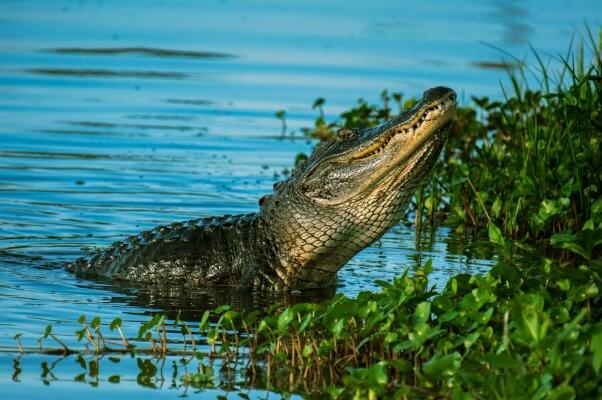
The most noticeable difference between alligators and crocodiles is their teeth. Alligators have a large fourth tooth in their lower jaw that fits inside their upper jaw when they close their mouths; with crocodiles, these teeth are visible when their mouths are closed.
Read more
Alligators inhabit swamps, tidal marshes, creeks, rivers, canals, ponds, lakes, and reservoirs. One of only a few species—including humans and beavers—who create wetland habitat, alligators use their snouts, forefeet, and tails to burrow “gator holes” that fill with water and can be the size of backyard swimming pools. To survive subfreezing temperatures, these crafty animals move to shallow water, stick their nostrils above the surface, and let their snouts become frozen into the ice.
Mother crocodiles and alligators are very protective of their babies, and hatchling alligators generally stay together in a “pod” for one to three years. Alligators communicate with a variety of sounds, including coughing, hissing, distress yelps, hatching calls, bellowing, and vocalizations that are not audible to humans and that can travel very long distances.
Alligators are often kept in filthy, crowded tanks on alligator “farms” before being clubbed and skinned alive.
You Can Make a Difference
Top retailers such as Topshop, Ann Taylor, Adidas, H&M, and Victoria’s Secret have vowed to steer clear of exotic skins. Please join them by always choosing fake snake, mock croc, and other animal-friendly options. For ideas, check out PETA’s Shopping Guide to Compassion Clothing and How to Wear Vegan feature.
You can encourage others to shed exotic skins from their wardrobes too: Share PETA’s shocking exposé, narrated by Joaquin Phoenix, which shows exactly what happens to alligators, lizards, and snakes before they are made into bags and belts.
